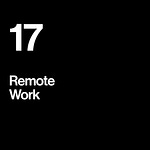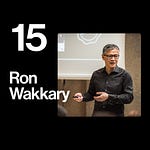Supported by:
Daylight Computer: the healthiest computer
Baked Graphics: amazing 3D video mockups
Framer: the best website builder for designers
ProtoPie: the best hi-fidelity interface prototyping tool
Timmy Ghiurau is an innovation leader at Volvo Cars, and Carlos Calva is an AI and augmented reality entrepreneur. Both of them are experts in virtual reality, augmented reality, game engines, and other 3D interactive technologies, with experiences spanning design, engineering, and business. Timmy originates from the worlds music, fashion, and culture; while Carlos has been building projects for clients that include NASA and multiple branches of the US military.
We had this conversation in front of a small live audience at Timmy’s workspace, the Open Innovation Arena at Volvo Cars – a multi-disciplinary platform within the company that makes preparations for a diverse range of futures and great uncertainties.
The themes of our conversation, recorded at the end of 2021, were the hot topics of the year: the metaverse, AI, and NFTs. These trends dominate conversations in tech today. The metaverse is expanding new graphics and interaction technologies to a massive role in our lives. NFTs embody value, identity, and symbolism that is digital-native (and metaverse-ready). AI promises immense convenience and creative possibilities in the digital world.
But how far have we come towards realizing these promises today, and what is on the horizon? How do these technologies serve the needs and desires of human societies – like safety, prosperity, diversity? How are established companies, like Volvo, integrating these trends into their business? In a wide-ranging conversation, we tried to answer these questions with our stories and insights.
Special thanks to David Peterson, who kindly stepped in last minute to help us record the video for this episode.
Links
Apple's Augmented Reality (AR) Creation Tools: https://developer.apple.com/augmented-reality/tools/
ARCAR: On-Road Driving in Mixed Reality by Volvo Cars by Florin-Timotei Ghiurãu, Mehmet Aydın Baytaş, and Casper Wickman: https://www.baytas.net/research/pub/2020_UIST_ARCAR.pdf
Big Five Personality Traits on Wikipedia: https://en.wikipedia.org/wiki/Big_Five_personality_traits
Bored Ape Yacht Club: https://boredapeyachtclub.com/
Decentraland: https://decentraland.org/
Gravity Sketch: https://www.gravitysketch.com
Mixed Reality Toolkit (MRTK): https://github.com/Microsoft/MixedRealityToolkit-Unity
Redirected Walking on Wikipedia: https://en.wikipedia.org/wiki/Redirected_walking
Slush: https://slush.org
Teslasuit: https://teslasuit.io
The Embedded Entrepreneur by Arvid Kahl: https://geni.us/embedded-entrepreneur
The Sandbox: https://www.sandbox.game
Timmy Ghiurãu – Innovating in Virtual Reality (interview by Mehmet Aydın Baytaş)
Tony Parisi's Blog: https://tonyparisi.medium.com
Tvori: https://tvori.co
Unity: https://unity.com
Unreal Engine: https://www.unrealengine.com
Varjo XR-1 announcement: https://varjo.com/press-release/varjos-xr-1-developer-edition-now-available-and-shipping/
VRDays: https://vrdays.co















Timmy Ghiurau and Carlos Calva at Volvo Cars: Metaverse, AI, NFTs